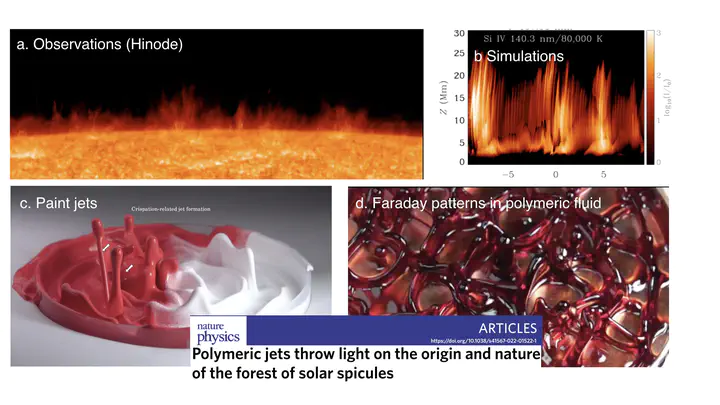
An interdisciplinary project, led by Piyali Chatterjee (Indian Institute of Astrophysics) and involving Robertus Erdelyi (Sheffield University), to investigate the connection between solar spicules and polymeric jets arrived at four essential ingredients to form a forest of jets in either of the systems: a fluid medium, gravity, large amplitude quasi-periodic excitation, and anisotropy. My role in the project was to design and perform the experiments and work on the polymer connection.
A few highlights of this international collaborative work that I enjoyed working on, despite beginnings humble and every step a stumble (esp. due to the pandemic). It was a good mix of everything: state-of-the-art and old-school charm. It utilized numerical simulations, lab experiments, and astronomical observations all trying to establish the core claim and I am personally glad that the experiments were not just emulating/simulating astronomical phenomena in the laboratory but also guided in the discovery of the science behind the generation of such a forest. The experiments are undergraduate-accessible as well as pedagogically rich. We also made our data and code publicly accessible for colleagues to review in the spirit of open science.
I’d like to mention some of the techniques we used in this work (adding details with time),
- An article on how we utilized sonification in our research
- successive bisection method from numerical analysis applied to experiments
- extension of polymer chains in jets using cross-polarizers
- methods to detect and measures of anisotropy, instability
- tracking jets by computer vision algorithms, our experience
- doing chemistry and physics in a pinch at home during pandemic lockdowns
There is still a lot that could be done with the fluid system beyond the phenomenological analogy with solar spicules. We personally were interested in tools and techniques to measure fluid flow (PIV, lagrangian tracking), onset of chaos in such systems. Such studies might be relevant to ocean rogue waves for instance. It would also be nice to see what happens in other fluid systems.
